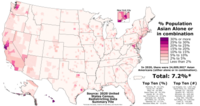
Photo from wikipedia
Abstract Satellite remote sensing is an important tool to retrieve terrestrial evapotranspiration (ET). Widely-used MOD16 ET product (MOD-ET) is a representative of Penman-Monteith method coupled with MODerate Resolution Imaging Spectroradiometer… Click to show full abstract
Abstract Satellite remote sensing is an important tool to retrieve terrestrial evapotranspiration (ET). Widely-used MOD16 ET product (MOD-ET) is a representative of Penman-Monteith method coupled with MODerate Resolution Imaging Spectroradiometer (MODIS) optic observations. Although MOD-ET has been extensively evaluated over the world, its accuracy under various cloud conditions remains unevaluated. Combining MODIS-observed cloud cover (Frc) and in-situ measurements at sixteen forests sites in East Asia, we evaluated 8-day MOD-ET and its primary MODIS inputs (i.e. LAI, FPAR and albedo) from clear to cloudy sky. A new satellite microwave ET method based on microwave Emissivity Difference Vegetation Index (EDVI-ET) was also compared with MOD-ET. Results showed that the accuracy of MOD-ET was highly variable under the changing Frc over the forests. The largest bias (>30%) in MOD-ET was found under Frc 30%) deteriorated the bias in MOD-ET (20%–30%). In contrast, EDVI-ET performed stably with lower bias ( 0.81) under other sky conditions. Further investigation found that MOD-ET over four tropical coastal forests contributed most to the bias, especially under least cloudy sky. A case study at a tropical forest showed that MODIS LAI/FPAR and surface albedo products were overestimated, which could directly cause the overestimation of canopy-scale conductance and the underestimation of net solar radiation in MOD-ET method, respectively. Analysis showed that the bias in MOD-ET was significantly related to the bias in MODIS LAI under various Frc, but it was weakly related to that in MODIS albedo, suggesting that LAI-based conductance might dominate the overestimation of MOD-ET. During a consecutive cloud cover period when fewer reliable MODIS pixels are available, slight increase of clouds partly reduced MODIS-observed signals of LAI/FPAR and increased those of albedo over the tropical forest, resulting in the lower bias in MOD-ET. More clouds reduced surface MODIS albedo and might increase the uncertainty in all-sky shortwave radiation from reanalysis data, which deteriorated MOD-ET accuracy under overcast sky. Our study highlighted the importance of cloud impacts on the satellite ET estimation.
Journal Title: Remote Sensing of Environment
Year Published: 2021
Link to full text (if available)
Share on Social Media: Sign Up to like & get
recommendations!